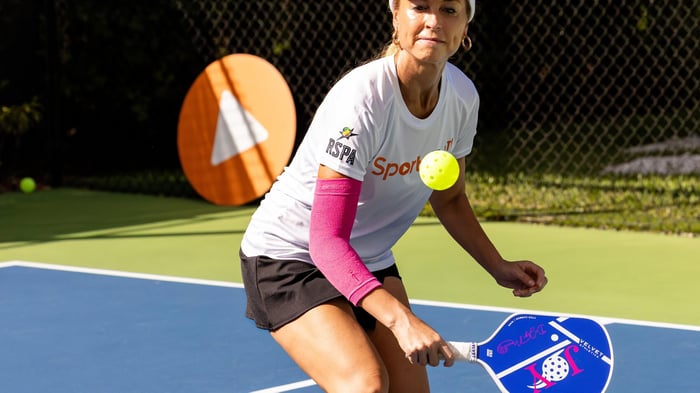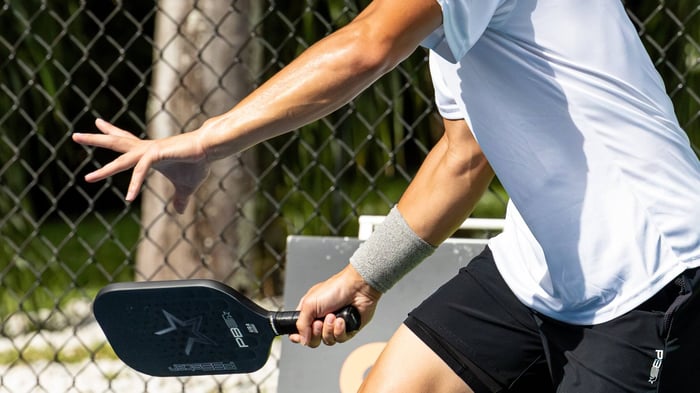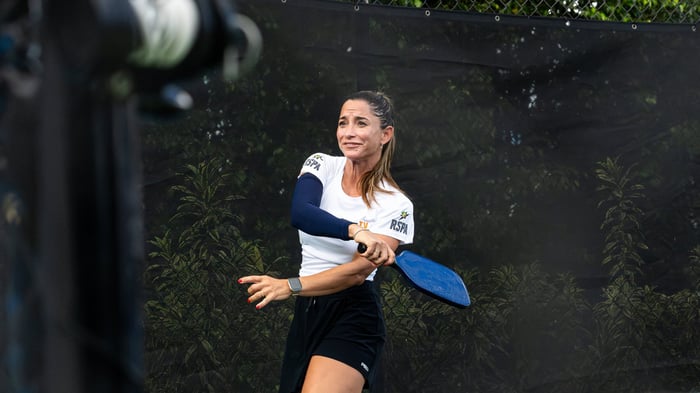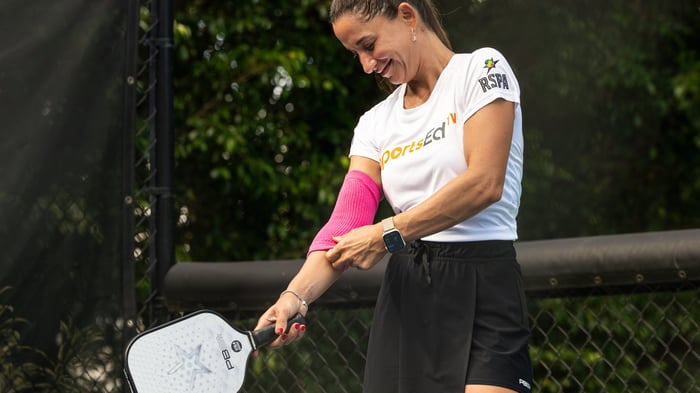Key takeaways:
A structured pickleball practice routine transforms casual play into measurable skill development, helping players avoid plateaus and achieve consistent improvement.
Dynamic warm-ups, targeted drills, and advanced routines are essential to a practical practice session, building physical and mental readiness for competitive play.
Consistent practice enhances individual skills and fosters community, teamwork, and camaraderie, making the game more enjoyable and rewarding.
Building an effective practice pickleball routine is one of the most reliable ways to level up your game. Improvement doesn’t come from random drills or casual rallies but from focused, structured training that targets your skills, strategy, and mindset. Whether just learning the ropes or preparing for competitive play, consistent practice ensures that every session moves you forward purposefully.
The proper routine builds confidence and capability with every rep, from warm-ups and consistency drills to pressure-tested game simulations. Each session becomes a tool to sharpen execution, reinforce smart habits, and train like you play. At PB5star, we support that growth with game-ready routines and performance-driven apparel that moves with you every step of the way.
Why a structured pickleball practice routine matters
A well-planned pickleball practice routine transforms casual court time into intentional progress. Rather than just going through the motions, structured training helps you stay focused, build skills more efficiently, and track your improvement over time. With consistent routines, you can set measurable goals, stay motivated, and see noticeable gains in performance and confidence.
Structured sessions also reveal problem areas that might go unnoticed during recreational play. For example, your third shot might drop in accuracy under pressure, or your footwork might falter during fast-paced exchanges at the net. A purposeful routine allows you to diagnose and address these weaknesses with specific drills, ensuring that every session builds on the last and contributes to a stronger, more well-rounded game.
Dynamic warm-ups: preparing body and mind for peak play
A proper warm-up sets the foundation for every successful practice session. Dynamic preparation improves mobility, boosts reaction time, and helps prevent injury, ensuring you're physically and mentally ready to maximize your time on the court.
Forward and lateral lunges: Activate major muscle groups and prepare your lower body for explosive side-to-side movement.
Arm circles and leg swings: Prime your shoulders, hips, and joints for serving, volleying, and sustained rally play.
Agility ladder drills and shadow swings: These exercises allow you to rehearse footwork patterns, elevate your heart rate, and build rhythm and focus.
Rotational core warm-ups: Engage your midsection with torso twists and standing crunches to support stable, consistent shot mechanics.
Visualisation and breathwork: Center your attention with a few moments of mental rehearsal and deep, controlled breathing to enter the session purposefully.
Solo adaptations: To stay sharp when practicing alone, use a wall for shadow swings or outline footwork paths with cones.
A dynamic warm-up primes your body for movement and your mind for focus. With just a few minutes of preparation, you can prevent injuries, sharpen execution, and step onto the court ready to train with intensity and purpose.
Core drills for consistency and control
Building reliable shots requires focused repetition and smart practice design. These pickleball consistency drills form the foundation of competitive play, transforming unreliable shots into consistent strengths you can confidently deploy during high-stakes matches.
Partner dinking with figure 8 pattern: One player dinks down the line while the other goes cross-court, sharpening touch and control at the kitchen line.
Third-shot drop and volley sequences: Practice with partners or groups to improve timing, simulate pressure, and build accountability in transition play.
Solo wall drills and self-fed routines: Work independently on ball control, reaction time, and paddle precision at your own pace.
Groundstroke repetition sessions: by hitting 50-100 balls in a 15-minute session with specific targets, building the muscle memory that separates good players from great ones
Performance tracking: Log success rates, streaks, and accuracy metrics to monitor growth and turn each drill into measurable progress.
Consistency doesn’t come from guesswork; it’s earned through structure, feedback, and repetition. With these drills in your routine, you’ll build the steadiness and shot reliability that define competitive success.
Doubles practice: sharpening team strategy and communication
Doubles play demands a different mindset than singles; success hinges on seamless partnership and tactical positioning. A well-designed pickleball doubles practice routine transforms two individual players into a cohesive unit that moves, communicates, and strategizes as one.
Practice synchronized positioning drills: Practice moving with your partner as you advance to the Non-Volley Zone or retreat on defense. This reinforces balanced court coverage and ensures you stay connected throughout each point.
Establish clear communication signals: Use structured callouts like “mine,” “yours,” or “switch,” along with visual cues such as hand signals for serve direction. These habits reduce hesitation during critical moments and help build smooth communication.
Run rotational partner training sessions: Rotate partners during practice to develop versatility and adaptability. Adjusting to different play styles improves your ability to strategize on the fly and makes you a more reliable teammate in competitive settings.
Match simulation drills with scoring pressure: Set up point-based games that mimic tournament formats, encouraging players to perform under realistic conditions. This helps teams practice decision-making, composure, and focus when the score matters.
Focus on the four-dink drill progression: Focus on coordinated soft play before transitioning to an aggressive shot. This drill teaches both partners how to construct points strategically, combining patience with well-timed offensive opportunities.
A strong doubles partnership doesn’t happen by chance; it results from purposeful drills, shared focus, and consistent communication. With the right practice structure, you and your partner can sharpen your teamwork and compete with greater confidence and clarity.
Advanced routines: refining power, precision, and mental toughness
When you're ready to push beyond intermediate play, your advanced pickleball practice routine becomes your competitive edge. These sessions transform raw talent into match-winning performance, combining explosive power drills with the mental sharpness that defines championship-level play.
Master high-intensity interval drills: Alternate between soft dinks and sudden speed-ups to build explosive shot variation. This drill develops timing, shot disguise, and the ability to switch from neutral to offensive play in a single motion.
Target-based pressure drills: Hit specific court zones repeatedly while maintaining rally pace, forcing you to balance control with intensity. These drills sharpen placement and prepare you for the precision required in tournament-level rallies.
Incorporate advanced footwork patterns: Use cone ladders, figure-eight movements, and live point play to reinforce balance and directional recovery after aggressive strokes or off-balance returns. Better footwork equals better control under pressure.
Distraction and momentum-shift scenarios: Practice during intentional interruptions or simulate losing streaks to build the ability to refocus and reset. This mental conditioning helps you stay grounded when momentum swings during real matches.
Partner up with high-level players: Surround yourself with others who push your limits and elevate the intensity. Training with like-minded players turns every advanced session into a true test of focus and adaptability.
Advanced routines bring out your competitive edge. When you combine purposeful drills with mindset training and elite-level intensity, you transform practice into preparation and step onto the court ready to perform with clarity, strength, and confidence.
Sample weekly practice routine
An intense practice routine doesn’t have to be overwhelming or time-consuming; it just needs to be focused and repeatable. By dedicating a few well-planned sessions each week, you can build consistency, develop confidence, and steadily sharpen every area of your game. The schedule below offers a balanced mix of drills, movement work, and competitive preparation to help players of all levels train with purpose.
Day 1: Foundation and footwork focus
Begin with a dynamic warm-up, then spend 20 minutes on groundstroke consistency and 15 minutes on footwork drills (ladder, cone movement). End with 10 minutes of solo wall work or target drills.
Day 2: Dinking and net control
Focus 30 minutes on dinking patterns (e.g., cross-court, 4-dink progression) and 15 minutes of quick volley exchanges at the net.
Day 3: Optional rest or light solo practice
Optional rest day or light 30-minute solo session with shadow swings, wall volleys, and serve placement drills. Great for form maintenance without physical strain.
Day 4: Doubles strategy and match simulation
Work with a partner or small group on synchronized movement, communication drills, and simulated game scenarios (e.g., third-shot drop under pressure, serve/return strategies).
Day 5: Advanced routines and mental focus
Practice high-intensity interval drills, serve targets under pressure, and play decision-making games. To reinforce mental sharpness, conclude with 5–10 minutes of visualization or breathwork.
Following a weekly structure like this creates a rhythm that balances physical training, tactical development, and recovery. Even small, consistent efforts add up to big gains over time, making you a more skilled player and a more confident and competitive one.
Frequently asked questions (FAQs) about pickleball practice routines
Whether you're fine-tuning your dinks or mastering doubles strategy, these frequently asked questions address the practical challenges that drive real improvement on the court. Players at every level face similar hurdles when building training sessions that deliver measurable results and lasting confidence.
What are the best pickleball drills for improving consistency?
The most effective consistency-building exercises focus on repetitive movements that create reliable muscle memory and shot precision. Dinking sequences like straight-ahead exchanges and crosscourt forehand patterns help you maintain control in high-pressure kitchen battles. Wall work and self-fed ball exercises keep your skills sharp, turning every training session into a stepping stone toward your next breakthrough.
How can I structure a strategic doubles practice session?
Strategic doubles training should prioritize positioning exercises, communication patterns, and synchronized movement that transforms two players into one cohesive unit. Begin with partner positioning sequences where you move as a connected team, then advance to game-like pressure situations that demand quick decisions and tactical shot placements.
What should a beginner include in their first training sessions?
New players should start with fundamental hand-eye coordination exercises like paddle-up sequences, where you control the ball while moving around the court to build confidence and feel. The selfie ball bounce exercise, bouncing the ball from ground to paddle repeatedly, develops the touch and timing that separate recreational players from competitors.
How do advanced players refine their skills with focused training routines?
Advanced competitors benefit from high-intensity interval sessions that replicate tournament pressure while incorporating mental toughness challenges. Target-based accuracy exercises, like hitting specific court zones under time pressure, and game simulation scenarios, help maintain peak performance when the stakes are high..
Practice with confidence and style
A consistent and intentional practice pickleball routine turns your time on the court into steady progress you can feel and measure. Every drill serves a purpose, from refining footwork and building shot consistency to strengthening teamwork and mental resilience. Structured sessions create a clear path forward, so you're not just playing but improving.
The more purposeful your training becomes, the more confidence you'll carry into competitive play. Whether working solo or pushing your limits with a partner, the proper routine helps you show up sharper, faster, and more focused each time you play. At PB5star, we’re committed to helping you build that edge with high-performance gear designed to elevate your game.







